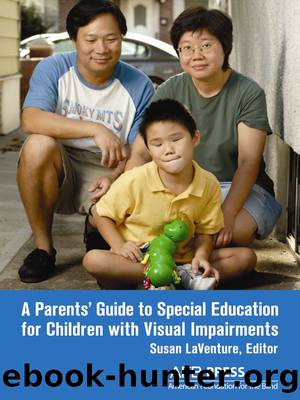A Parents' Guide to Special Education for Children with Visual Impairments by LaVenture Susan;

Author:LaVenture, Susan;
Language: eng
Format: epub
Publisher: American Foundation for the Blind Press
Published: 2013-03-23T00:00:00+00:00
OBTAINING SPECIAL EDUCATION SERVICES
Children with multiple disabilities are entitled to the same services and supports as students whose only disability is a visual impairment, as guaranteed by the federal Individuals with Disabilities Education Act (IDEA). These services include support from a teacher of visually impaired students, access to orientation and mobility (O&M) services, and a learning media assessment (an evaluation to determine whether your child will do better with braille, print, another format, or some combination for obtaining information). To receive vision-related services, children with multiple disabilities must meet certain medical and functional criteria. These are determined by reports from eye care physicians and a functional vision assessment: an evaluation of how a child uses vision in real-life situations and of how the visual impairment may compromise independence, mobility and educational progress. (See Chapters 1, 3, and 6 for more information.) However, the Individualized Family Service Plan (IFSP) or Individualized Education Program (IEP) teams, of which you are an integral member, typically determine which services children are eligible for and how they are delivered. (See Chapter 4 for more information on the IFSP and IEP.)
To find out how to obtain services, the family of a child younger than 3 might typically contact a local early intervention agency or a program for visually impaired persons. However, a good place to start is with your local âchild findâ agency, especially if the child is age 3 or older, as explained in Chapters 1 and 2. IDEA requires the states to identify children in need of special services as early as possible, in a process referred to as âchild find.â Throughout the United States, local school districts, under the state departments of education, function as child find agencies.
In addition, the law requires each state to have a lead agency specifically for early intervention services, and this agency may or may not be the same as the child find agency in your state. The location of lead agencies for early intervention services within state governments varies from state to state. They are usually located, however, in the state department of health, human services, education, or rehabilitation. You may hear these lead agencies called âPart Câ agencies, referring to the section in the legislation that describes them. (See Chapter 2 for more information on early intervention services.)
Local school districts are important sources of information, as are directors of special education and supervisors of programs for visually impaired students, agencies and organizations for people who are blind or visually impaired, and state schools for blind students. A helpful resource for locating the Part C agency in your state, the state department of education, organizations and special schools for blind students, and other services is the AFB Directory of Services for Blind and Visually Impaired Persons in the United States and Canada, which is available in print and also online at www.afb.org under the âWhere Can I Find?â service finder.
Once your child has been found eligible for services from a program for the visually impaired students, a
Download
This site does not store any files on its server. We only index and link to content provided by other sites. Please contact the content providers to delete copyright contents if any and email us, we'll remove relevant links or contents immediately.
| Behavioral Disorders | Communicative Disorders |
| Gifted Students | Inclusive Education |
| Learning Disabled | Mentally Disabled |
| Physically Disabled |
The Art of Coaching Workbook by Elena Aguilar(50094)
Trainspotting by Irvine Welsh(21008)
Twilight of the Idols With the Antichrist and Ecce Homo by Friedrich Nietzsche(18292)
Fangirl by Rainbow Rowell(8782)
Periodization Training for Sports by Tudor Bompa(7908)
Change Your Questions, Change Your Life by Marilee Adams(7365)
This Is How You Lose Her by Junot Diaz(6428)
Asking the Right Questions: A Guide to Critical Thinking by M. Neil Browne & Stuart M. Keeley(5350)
Grit by Angela Duckworth(5292)
Red Sparrow by Jason Matthews(5190)
Paper Towns by Green John(4785)
Room 212 by Kate Stewart(4729)
Ken Follett - World without end by Ken Follett(4439)
The Sports Rules Book by Human Kinetics(4069)
Housekeeping by Marilynne Robinson(4056)
Double Down (Diary of a Wimpy Kid Book 11) by Jeff Kinney(3916)
Papillon (English) by Henri Charrière(3896)
Exercise Technique Manual for Resistance Training by National Strength & Conditioning Association(3779)
The Motorcycle Diaries by Ernesto Che Guevara(3775)
